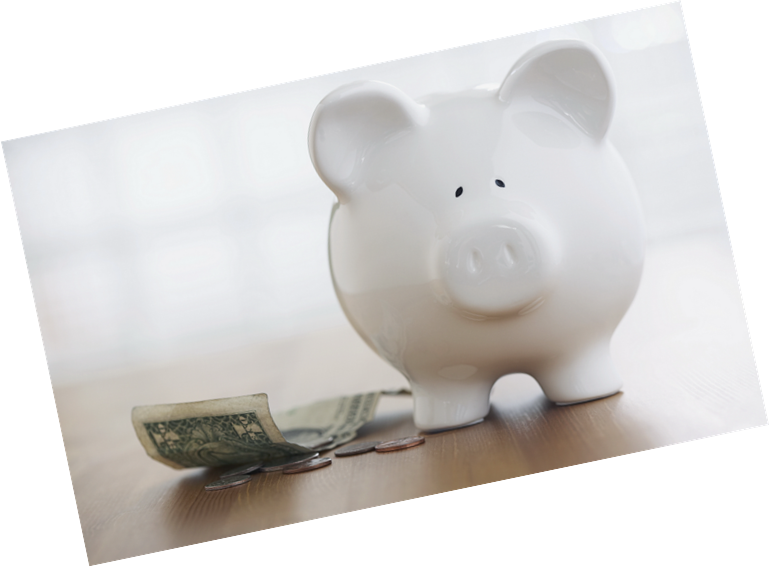- Преподавателю
- Иностранные языки
- Учебное пособие «Деньги. Валюта»
Учебное пособие «Деньги. Валюта»
| Раздел | Иностранные языки |
| Класс | - |
| Тип | Конспекты |
| Автор | Фоменко Е.А. |
| Дата | 15.03.2015 |
| Формат | docx |
| Изображения | Есть |





 Министерство образования и науки Краснодарского края
Министерство образования и науки Краснодарского края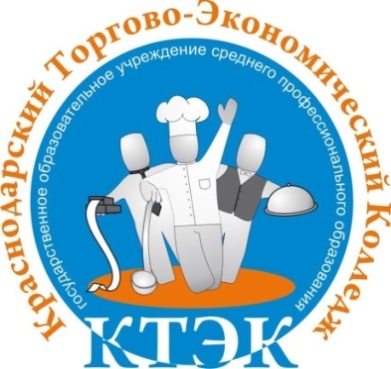
Государственное бюджетное профессиональное образовательное учреждение Краснодарского края "Краснодарский торгово-экономический колледж"
Фоменко Е.А.
«Деньги. Валюта»
Учебное пособие
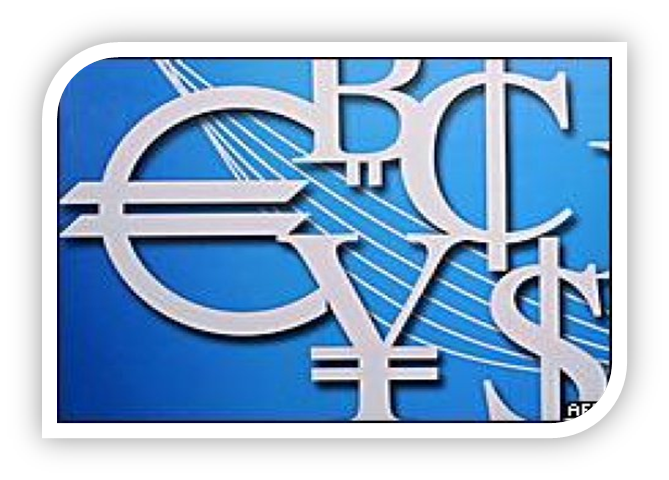
Краснодар, 2014
Составитель - Фоменко Е.А., преподаватель английского языка ГБПОУ КК «КТЭК»
Рецензент - Снежко Н.И., кандидат филологических наук, преподаватель английского языка Краснодарской государственной академии культуры и искусств
Настоящее учебное пособие предназначено для студентов специальности 38.02.01 Экономика и бухгалтерский учет по отраслям при изучении Раздела 3 «Введение в деловой английский» (см. Рабочую программу). В учебном пособии рассматривается содержание Темы 3.2. «Деньги. Валюта»: Из истории возникновения денег. Национальные валюты: английский фунт стерлингов, американский доллар. Национальные валюты: евро, российский рубль. Проблема подделки денег. Методы защиты банкнот. Обмен денег. Языковые клише. Понятия «инфляция», «дефляция», «девальвация» валюты.
Представленное учебное пособие рассчитано на 8 аудиторных часов (согласно Рабочей программы) и содержит тексты, лексико-грамматические задания, вопросы для самоконтроля и тестовые задания для самопроверки (Progressive Test), дополнительный материал для студентов.
Цель настоящего учебного пособия - помочь студентам сформировать навыки чтения и перевода при изучении данной темы.
Утверждено на заседании цикловой методической комиссии
гуманитарных и социально-экономических дисциплин
№ __ от _____________ 2014 г.
СОДЕРЖАНИЕ
-
Введение
4
-
Текст 1 «Из истории денег»
5
-
Дополнительный материал «Это интересно»
10
-
Текст 2 «Английские банкноты и монеты»
12
-
Grammar revision
17
-
Дополнительный материал «Это интересно»
21
-
Текст 3 «Американские деньги»
22
-
Grammar revision
27
-
Дополнительный материал «Это интересно»
29
-
Текст 4 «Национальная валюта: евро»
30
-
Текст 5 «Национальная валюта: российский рубль»
33
-
Текст 6 «Обмен денег»
35
-
Grammar revision
37
-
Текст 7 «Проблема подделки денег. Методы защиты банкнот».
40
Заключение
44
Литература
49
-
ВВЕДЕНИЕ
Целью написания данного учебного пособия послужило отсутствие единого учебного и дидактического материала при изучении Раздела 3 «Введение в деловой английский» (см. Рабочую программу). В учебном пособии рассматривается содержание Темы 3.2. «Деньги. Валюта»: Из истории возникновения денег. Национальные валюты: английский фунт стерлингов, аме-риканский доллар. Национальные валюты: евро, российский рубль. Проблема подделки денег. Методы защиты банкнот. Обмен денег. Языковые клише. Понятия «инфляция», «дефляция», «девальвация» валюты.
Представленное учебное пособие рассчитано на 8 аудитор-ных часов (согласно Рабочей программы) и содержит тексты, лек-сико-грамматические задания, вопросы для самоконтроля и тесто-вые задания для самопроверки (Progressive Test), дополнительный материал для студентов.
Настоящее учебное пособие призвано помочь студентам сформировать навыки чтения и перевода при изучении данной те-мы, а преподавателям иметь в наличии готовый УМК: тексты, лексический и грамматический материал, разноуровневые задания и упражнения по данной теме.
Texts
1 Glimpses of history of money
2 English banknotes and coins
3 American money
4 The Euro
5 The Russian Ruble
6 Changing money over the counter
7 Counterfeiting
Grammar 1 Продолженные времена в пассивном залоге
Revision 2 The construction it was ...who/that...
3 Числительные 1-100
UNIT 3. INTRODUCTION TO BUSINESS ENGLISH.
TOPIC: 3.2. MONEY. CURRENCY.
TEXT 1: GLIMPSES OF HISTORY OF MONEY
At different periods of time and in different parts of the world many different commodities have served as money.
These commodities were: cattle, sheep, furs, leather, fish, tobacco, tea, salt, shells etc. The illustration shows shell money used by early settlers in North America. The shells were threaded into strings or belts called wampum*. The experts underline that to serve effectively as money; a commodity should be fairly durable, easily divisible, and portable. None of the above-mentioned commodities possessed all these qualities, and in time they were superseded by precious metals.
First they were superseded by silver and later by gold. When a payment was made the metal was first weighed out. The next stage was the cutting of the metal into pieces of definite weight and so coins came into use.
Paper money first came into use in the form of receipts given by goldsmiths in exchange for deposits of silver and gold coins. After goldsmiths became bankers their receipts became banknotes. That's how the first banknotes came into existence.
At first coins were worth their face value as metal. But later token coins of limited value as legal tender were issued. Now smaller denomination coins are made from bronze and are often referred to as coppers. Bigger denomination coins are made from cupronickel and are usually called silvers or silver.
Vocabulary
glimpse
[glimps]
быстрый взгляд
glimpses of history
немного об истории
to serve
служить, использоваться
to serve as smth
служить, использоваться в качестве чего-либо
fur
мех
leather
[ ]
]
кожа
shell
ракушка
settler
поселенец
to thread
нанизывать
to underline
to stress
to emphasise
[ ]
]
подчеркивать, выделять
divisible
[di'vizibl]
делимый
portable
портативный, компактный
above-mentioned
вышеуказанный
quality
['kwoliti]
качество, свойство
to supersede
[ ]
]
замещать
precious
[ ]
]
драгоценный, благородный
precious metal
драгоценный металл
to weigh
[wei]
весить, взвешивать
to weigh out
взвешивать
weight
[weit]
вес
piece
[pi:s]
кусок
to cut into pieces
резать на куски
receipt
квитанция, расписка
goldsmith
[ ]
]
ювелир
existence
существование
to come into existence
возникнуть, появиться
worth
[ ]
]
цена, стоимость
to be worth face value
иметь такую же стоимость, как нарицательная цена
token
знак, символ
token coin
[ ]
]
разменная монета
EXERCISES
-
Insert the correct prepositions:
... different periods ... time
... different parts ... the world
in time they were superseded…
precious metals
they were superseded ...
either gold or silver
to cut the metal ... pieces
these coins were made ... bronze
they are often referred ...
as coppers
so coins came ... use
then paper money came ... use
in exchange ... deposits
thus they came ... existence
none ... the commodities
some ... the goods
-
Make sentences from the following elements:
In the past
At present
many different commodities
cattle, sheep, furs, tea etc
silver and gold
paper banknotes and coins
goldsmiths' receipts
serve
served
as money
-
Find the answers in the text:
-
What are the requirements of a commodity to serve as money?
-
Why did precious metals start to serve as money?
-
What precious metal was used first to serve as money?
-
How did coins come into existence?
-
How did paper banknotes come into existence?
-
What coins are called silvers?
-
What are coppers?
-
Complete the sentences with the following words:
coin, metal, banknote, payment, bronze, coppers, silvers, denomination, cupronickel
-
At first coins were worth their face value as ...
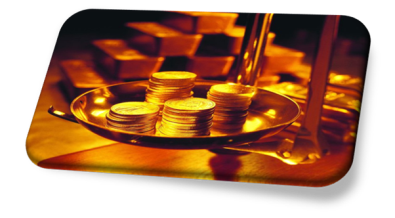
-
When a ... was made the ... was first weighed out.
-
This ... is 10 pence worth.
-
This ... is 10 dollars worth.
-
Now smaller denomination coins are made from ... and are often referred to as ...
-
Bigger... coins are made from ... and are usually called ...
-
Sum up what the text says about:
the money in the past
the way banknotes appeared
the metals of which coins were and are made
the silvers and coppers.
IT'S INTERESTING…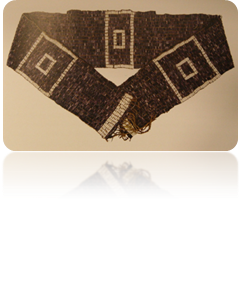
* Wampum is traditional shell beads of the Eastern Woodlands tribes of the indigenous people of North America. Wampum include the white shell beads fashioned from the North Atlantic channeled whelk shell; and the white and purple beads made from the quahog, or Western North Atlantic hard-shelled clam.
Wampum were used as money by the Native Americans, and were kept on strings like Chinese cash. European colonists adopted wampum as their own currency; however, the Europeans' more efficient production of wampum caused inflation and ultimately the obsolescence of wampum as currency. The slang phrases "clams" and "shelling out" come from wampum.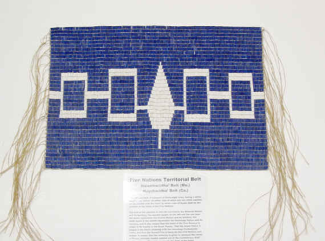
ЭТО ИНТЕРЕСНО …
Ва́мпум - нанизанные на шнуры цилиндрические бусины из раковин, служившие североамериканским индейцам для различных целей.
Эти пояса у алгонкинов и особенно у ирокезов имели ряд особых функций: они были украшением одежды, служили валютной единицей, а главное - с их помощью передавались разные важные сообщения. Такие вампумы у ирокезских племён обычно доставляли особые гонцы - вампумоносцы. Развитие вампумовых записей, по всей вероятности, привело бы к созданию и развитию у североамериканских индейцев письма. Исключительно посредством вампумов долгое время оформлялись договоры между белыми и индейцами. Сохранился «записанный» договор о союзе между знаменитым Пенном (основателем Пенсильвании) и квакерами, с одной стороны, и делаварами - с другой как залог мира и дружбы белых и индейцев. Согласно этому договору делавары уступали квакерам довольно обширную часть территории своего племени. На этом вампуме изображён индеец и белый, символически держащиеся за руки.

Вампум Пенна
Однако вампумы служили не только для передачи сообщений и заключения договоров. Простейшими условными символами на них обозначались и наиболее важные события из истории племени. По этим «записям» старики, владеющие искусством «чтения» вампумов, знакомили новые поколения воинов с племенными традициями. Насколько важным считалось такое составление и чтение вампумов у некоторых алгонкинских и ирокезских племён североамериканского востока, лучше всего иллюстрирует тот факт, что имя легендарного Гайаваты (создателя наиболее значительного союза североамериканских индейцев - Лиги ирокезов) буквально означает «Тот, кто составляет вампумы».
Вскоре после появления белых торговцев индейцы перестали делать вампумы из простых ракушек и начали широко применять стеклянные бусинки, привозимые в Америку из северной Чехии.
TEXT 2 ENGLISH BANKNOTES AND COINS
The official currency of the United Kingdom is still keeping the pound sterling but the possibility of joining the euro is being widely debated.
The pound sterling is equal to one hundred pence.
English banknotes are issued by the Bank of England. As to coins they are minted also by this state bank.
There are banknotes of the following denominations:
-
£1
£20
£5
£50
£10
£100
The following coins are in circulation:
halfpenny
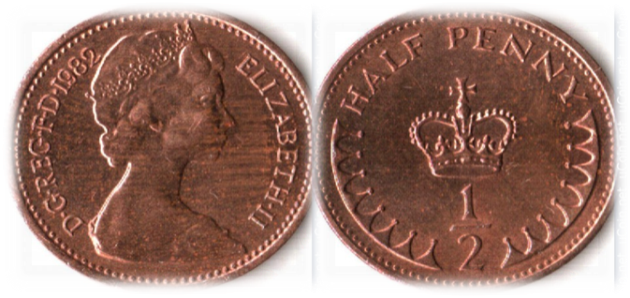
one penny
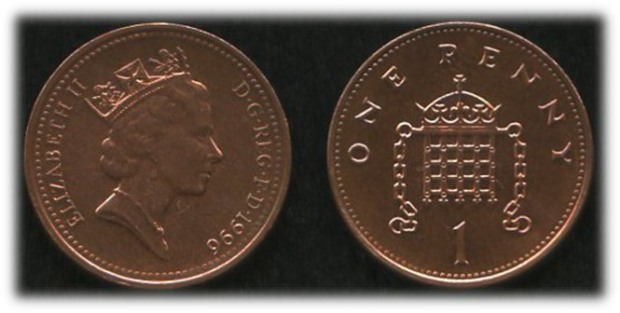
two pence
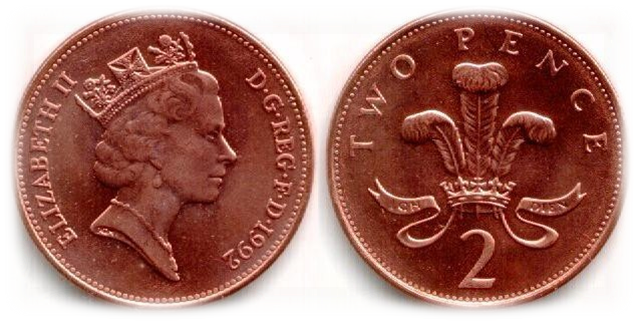
five pence

ten pence
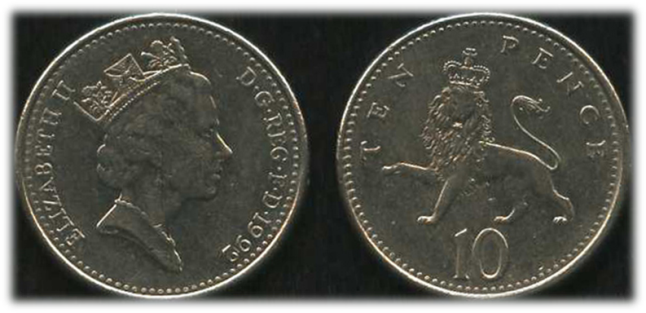
fifty pence
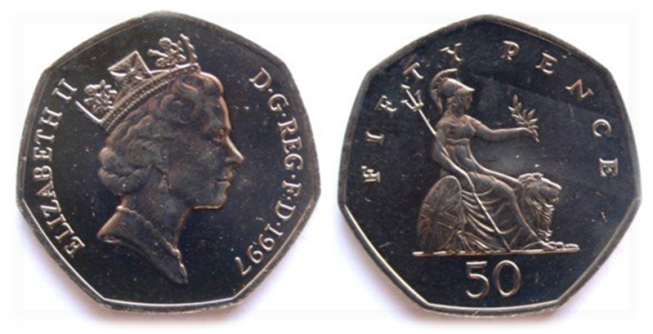
On the face of English banknotes one can read the denomination given both in figures and in words.
Then the inscription on the face of the banknote reads:
I promise to pay the bearer on demand the sum of...
And then there are two signatures. The first signature is that of the person authorized by the Government and the Bank of England. The second signature is that of the Chief Cashier.
The backs of English banknotes, like many other banknotes, feature portraits of different famous people.
■ The one pound banknote, for example, features Isaac Newton (1642-1727), a well-known English scientist who made a few very important discoveries including gravitation law.

■ The back of the five pound note portrays the, Duke of Wellington - (1769-1852), a famous Irish general who defeated Napoleon at Waterloo, Belgium in 1815.

■ On the back of the ten pound note one can see Florence Nightingale (1820-1910), founder of the nursing profession. She volunteered as a nurse to Turkey to take care of the wounded soldiers from Crimean War, war of England and France versus Russia.

■ On the back of the twenty pound banknote features William Shakespeare (1564-1616), the greatest playwright of all time.
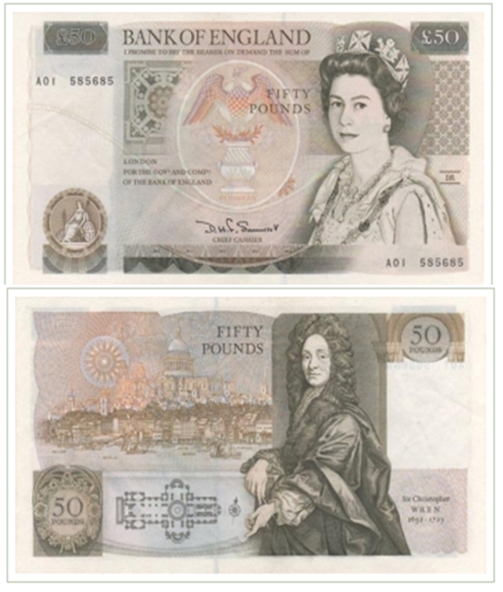
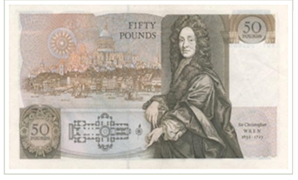
■ Here is the face and the back of £100:
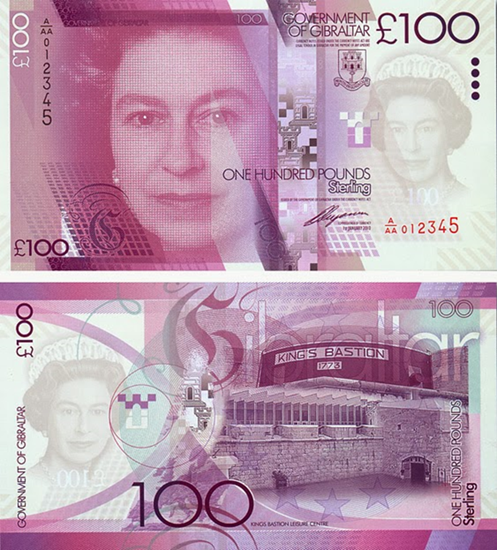

Vocabulary
currency
[ ]
]
валюта
equal
[ ]
]
равный
to be equal to smth
быть равным чему-либо
to mint
чеканить
denomination
достоинство, номинал
circulation
[ ]
]
обращение
to be in circulation
быть в обращении
face
лицевая сторона
on the face
на лицевой стороне
inscription
[ ]
]
надпись
to promise
обещать
bearer
[ ]
]
предъявитель
to bear (bore, borne)
нести
demand
требование
on demand
по требованию
signature
подпись
to authorize
[ ]
]
уполномочивать
cashier
[ ]
]
кассир
Chief Cashier
Главный кассир (важный
административный пост в Банке Англии)
to feature
[ ]
]
показывать, помещать
scientist
['saiantist]
ученый
discovery
[ ]
]
открытие
gravitation
притяжение, тяготение
gravitation law
закон тяготения
centre of gravity
центр тяжести
duke
герцог
to defeat smb
[di'fi:t]
наносить поражение к-л
to found
основывать
founder
основатель
to volunteer
[ ]
]
поступить добровольно
to take care
заботиться
wound
[wund]
рана
wounded soldier
раненый солдат
playwright
['pleirait]
драматург
Grammar Revision 1: Продолженные времена в пассивном залоге (Continuous Tenses, Passive)
Present Continuous, Passive
I am being interviewed.
You are being interviewed.
He/She is being interviewed.
We are being interviewed.
You are being interviewed.
They are being interviewed.
I am not being interviewed.
You are not being interviewed.
He/She is not being interviewed.
We are not being interviewed.
You are not being interviewed.
They are not being interviewed
Are you being interviewed?
Is he/she being interviewed?
Are you being interviewed?
Are they being interviewed?
Yes, I am.
No, I am not.
Yes, he/she is.
No, he/she is not.
Yes, we are.
No, we are not.
Yes, they are.
No, they are not.
Past Continuous, Passive
I was being interviewed.
You were being interviewed.
He/She was being interviewed.
We were being interviewed.
You were being interviewed.
They were being interviewed.
I was not being interviewed.
You were not being interviewed.
He/She was not being interviewed.
We were not being interviewed. You were not being interviewed.
They were not being interviewed.
Were you being interviewed?
Was he/she being interviewed?
Were you being interviewed?
Were they being intended?
Yes, I was.
No, I was not.
Yes, he/she was.
No, he/she was not
Yes, we were.
No, we were not.
Yes, they were.
No, they were not.
1. Present и Past Continuous, Passive, как и все Continuous Tenses, выражают действия, происходящие в определенный момент или период. И как все времена в пассивном залоге они выражают действия, направленные на лицо или предмет, указанные подлежащим предложения.
2. Future Continuous, Passive практически не употребляется.
3. Present и Past Continuous, Passive образуются с помощью вспомогательного глагола to be в Present или Past Continuous и причастия прошедшего времени смыслового глагола.
4. На русский язык глаголы в Present и Past Continuous, Passive переводятся с помощью неопределенно-личных предложений или глаголов в страдательном залоге:
My friend is being interviewed.
An exhibition was being held in that building when the workers started the reconstruction.
Сейчас интервьюируют моего друга.
В здании проводили какую-то выставку, когда рабочие начали реконструкцию.
EXERCISES
1 Underline the Predicates read and translate the sentences:
-
New coins are being minted in this country now.
-
Where are these banknotes being printed?
-
A new daughter company was being founded when he visited Newall Ltd. last year.
-
Are these products being widely sold throughout the world?
-
This product is being launched on the Russian market.
-
A very good exhibition is being held in Novosibirsk.
2 Find the equivalents in the text:
(1) Что же касается монет, то они …
(2) На лицевой стороне можно увидеть …
(3) На лицевой стороне написано …
(4) Первая подпись - это лица, уполномоченного правительством.
(5) На оборотной стороне английских банкнот, как и у многих других банкнот …
(6) На оборотной стороне изображен …
(7) Банкноты достоинством один фунт …
3 Find the answers to the following questions in the text:
(1) What is the official currency of the UK?
(2) What is the smallest unit?
(3) How many pence are there in one pound?
(4) What banknotes and coins are in circulation in the UK now?
(5) Who issues banknotes and mints coins in the UK?
(6) What famous people are featured on the back of various English banknotes?
4 Complete these sentences with the following words:
banknote, bearer, words, inscription, denomination, signature, Bank of England, Chief Cashier
(1) On the face of English banknotes one can read the …
(2) The ... is given both in figures and in …
(3) The ... on the face of the … reads: I promise to pay the … on demand fifty Pounds.
(4) The first ... is that of the person authorized by the Government and the …
(5) The second signature is that of the...
5 Sum up what the text says about:
the UK currency
English coins
the backs of English banknotes
the face of English banknotes
6 Have a look at a banknote (coin) which is in circulation now in Russia and say a few words about:
its denomination
its issuer
inscriptions, if any
portraits, if any
flags, if any
other pictures
7 Imagine you are speaking with an Englishman (or any other foreigner) about money. Compare two banknotes (coins) of the two countries. Act out this dialogue.
monetary unit
monetary agreement
monetary policy
International Monetary Fund
cheap money
dear money
easy money
hot money
ready money
moneys
money in cash
money market
money rate
money-box
money-changer
money-order
денежная единица
валютное соглашение
денежно-кредитная политика
Международный валютный фонд
дешевые деньги, деньги с низкой покупательной способностью*
дорогие деньги, деньги с высокой стоимостью займов*
легкие деньги, деньги при избыточном предложении кредита*
горячие деньги, большие массы краткосрочных капиталов*
деньги, которые могут быть выплачены сразу*
денежные суммы, валюты, монетные системы
наличные деньги
валютный рынок, рынок краткосрочных операций
ссудный процент
копилка
меняла
почтовый денежный перевод
ADDITIONAL INFORMATION
The name pound sterling appeared in the 12th century and meant pound of money as equaled on weight and at cost to pound of silver coins, sterling. And the very first coin is rapped out in 1489, before the discovery of America Columbus.
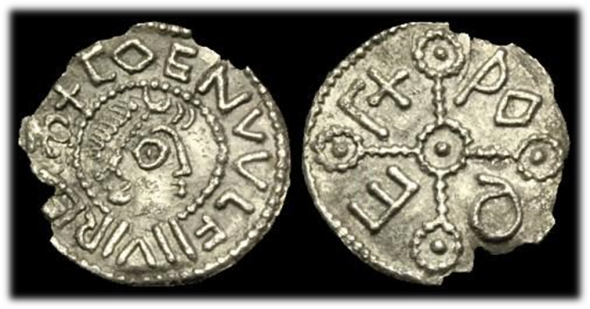
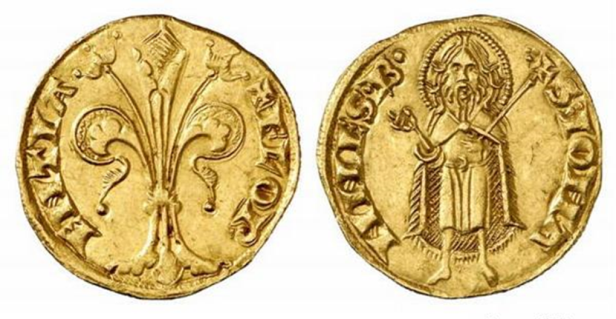

TEXT 3: AMERICAN MONEY
The American dollar is subdivided into one hundred cents.
The dollars are issued by the Federal Reserve System, established by Congress in 1913.
Here is the text on the face of an American ten dollar banknote: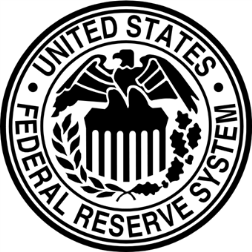
• ten dollars
• Federal Reserve Note
• The United States of America
• This note is legal tender for all debts public and private
• Washington D. C.
• Treasurer of the United States
• Secretary of the Treasury
On the face of American dollars one can also see the portraits of the following famous persons:
-
George Washington (1732-1799), the first President of the United States of America, who gave his name to the capital of the country. George Washington became the first President after the successful war of 13 British colonies for independence. After they won the war they formed 13 states and united to make the United States of America. Thus Independence was proclaimed on July 4, 1776.
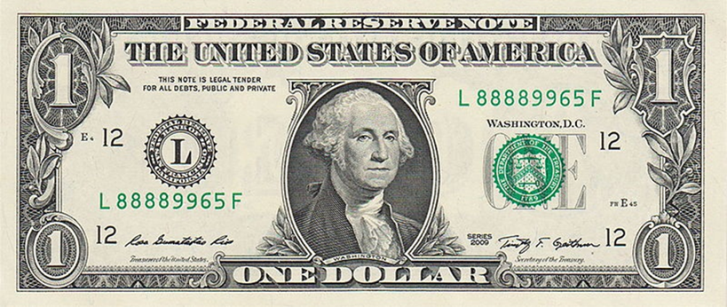
-
Thomas Jefferson (1743 - 1826) was an American Founding Father, the principal author of the Declaration of Independence (1776), and the third President of the United States (1801-1809). He was a spokesman for democracy, and embraced the principles of republicanism and the rights of the individual with worldwide influence. At the beginning of the American Revolution, he served in the Continental Congress, representing Virginia, and then served as a war time Governor of Virginia (1779-1781). In May 1785, he became the United States Minister to France and later the first United States Secretary of State (1790-1793) serving under President George Washington.
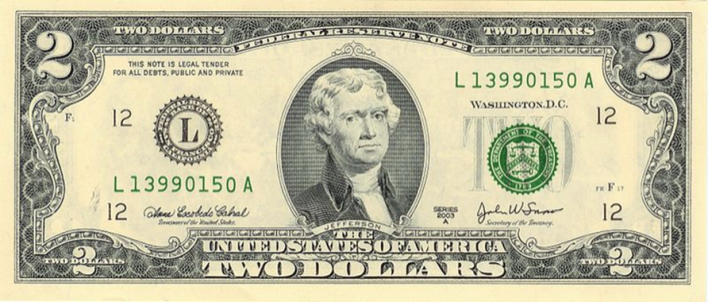
-
Abraham Lincoln (1809-1865), who was President from 1861 to 1865 after the war between the northern and southern states. It was he who proclaimed freedom of slaves of the south.
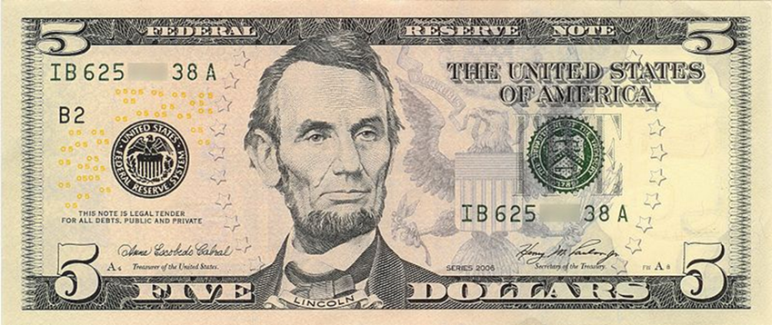
-
Alexander Hamilton (1755-1804), a famous American statesman, who fought in the Independence War together with general George Washington. Later he became the first Secretary of the Treasury.
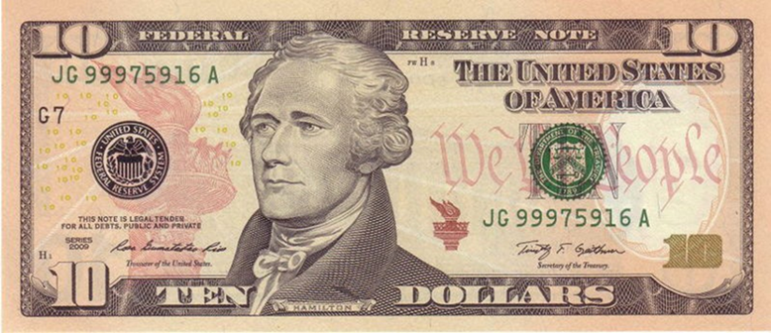
-
Andrew Jackson (1767-1845), who was President of the USA from 1829 to 1837, when Texas won independence from Mexico.
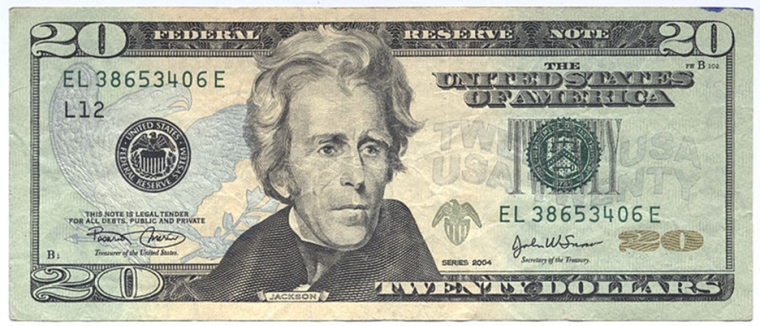
-
Ulysses Grant (1822-1885), who was President of the USA from 1869 to 1877 when the Centennial Exposition was held in Philadelphia.

-
Benjamin Franklin (1706-1790), a very popular public figure, writer, diplomat and scientist. It was he who invented bifocal spectacles among many other things.

On the back of banknotes various famous buildings are featured, such as:
-
Lincoln Monument, one of the monuments in Washington
-
US Treasury Building, in Washington
-
White House, house of every President, except George Washington, who only planned the capital of the USA.
-
US Capitol, which houses the Senate and the House of Representatives
-
Independence Hall, in Philadelphia, where Independence of the 13 British colonies was proclaimed.
All the banknotes bear the words: In God We Trust.
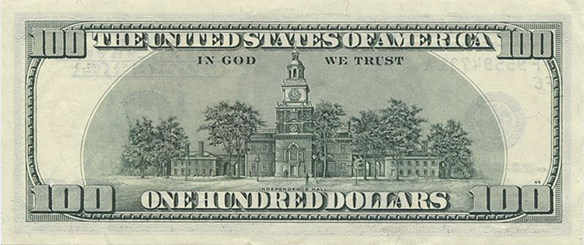
Vocabulary
to subdivide
[ ]
]
подразделять(ся)
to be subdivided into
подразделяться на
legal tender
законное платежное средство
treasure
[ ]
]
казна, сокровище
treasurer
[ ]
]
казначей
treasury
[ ]
]
Казначейство, Министерство финансов
to proclaim
[pro'kleim]
провозглашать
to proclaim freedom
провозгласить свободу
to proclaim independence
провозгласить независимость
success
[sлk'ses]
успех
successful
успешный
to win (won, won)
побеждать, выигрывать
to win the day
одержать победу
slave
раб
statesman
государственный деятель
to fight (fought, fought)
[fait, fo:t]
бороться
exposition
exhibition
выставка
to hold (held, held)
иметь силу (о законе); придерживаться (мнения)
monument
памятник, монумент
Grammar Revision 2: The construction it was … who/that …
It was he who proclaimed freedom of slaves of the South. Именно он объявил свободу рабам Юга.
It is the banknote that I want to have another look at. Я хочу еще раз посмотреть именно на эту банкноту.
It was on Sunday that I saw this film, Именно в воскресенье я видел этот фильм.
It was in London that they met for the first time, В Лондоне, да в Лондоне, они встретились впервые.
EXERCISES
1 Translate into English:
-
Именно он стал первым президентом страны.
-
Это его портрет изображен на оборотной стороне этой банкноты.
-
Именно в 1999 г. большинство стран Евросоюза перешли на евро.
-
В этой, да именно в этой стране началось производство стали.
-
Именно в Лондоне в 1851 г. проводилась первая всемирная выставка.
2 Choose the correct voice form of the Verb given in brackets:
(1) The American dollar (subdivides, is subdivided) into 100 cents,
(2) The English pound (subdivides, is subdivided) into 100 pence.
(3) The dollar (issues, is issued) by the Federal Reserve System.
(4) On the back of many American banknotes various famous buildings (featured, are featured).
(5) All the banknotes (bear, are borne) the words «In God We Trust»,
(6) The Federal Reserve System (established, was established) by Congress in 1913.
(7) Independence of the States (proclaimed, was proclaimed) on July 4, 1776.
(8) It was Abraham Lincoln who (proclaimed, was proclaimed) freedom of slaves.
3 Translate the inscriptions on the face and on the back of an American dollar note into Russian.
4 Sum up what the text says about:
the issuer of American dollar notes
the famous buildings on the back
the inscription on the face
American coins
5 Write what you know about the famous persons, whose portraits are featured on the face of American dollars:
George Washington
Abraham Lincoln
6 Imagine you are talking to an American. Exchange coins as souvenirs. And say a few words about the Russian coin. Act out this dialogue.
IT'S INTERESTING …
History of the Dollar of United States
Dollar comes from the word "Yoahimstaler" the name of the coin of the XVI century, which was made near silver mine in Yahymiv in Chech Republic. "Yaihimstaler" means "hill of Yahymiv". Later the word "Yoahimstaler" was shortened to "taller" and dutchmen changed it into a "doller". Englishmen turned it into "dollar". In America Spanish coin of 8 reals was called a dollar. Government of the USA introduced American money in 1785 and dollar became the main currency. The first dollars in the USA started to produce in 1794.
1794


History of the symbol of Dollar of United States
The symbol $, usually written before the numerical amount, is used for the U.S. dollar. The sign was the result of a late 18th-century evolution of the scribal abbreviation "PS" for the peso.
Another popular explanation is that it comes from the Pillars of Hercules on the Spanish Coat of arms on the Spanish. These Pillars of Hercules on the silver Spanish dollar coins take the form of two vertical bars and a swinging cloth band in the shape of an "S".
Yet another fictional explanation suggests that the dollar sign was formed from the capital letters U and S written or printed one on top of the other.

TEXT 4: THE EURO
The euro is the currency used by the Institutions of the European Union and is the official currency of the Eurozone, which consists of 18 of the 28 member states of the European Union.
The euro is the second largest reserve currency as well as the second most traded currency in the world after the United States dollar.
As of August 2014, with more than €995 billion in circulation, the euro has the highest combined value of banknotes and coins in circulation in the world, having surpassed the U.S. dollar.
Based on International Monetary Fund estimates of 2008 GDP and purchasing power parity among the various currencies, the Eurozone is the second largest economy in the world.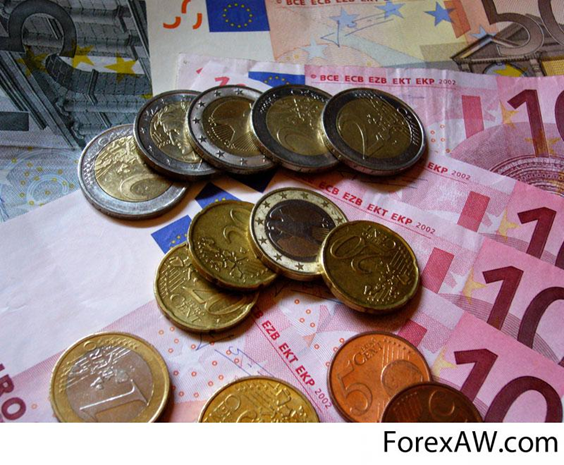
The new European Central Bank Headquarters under construction in Frankfurt, Germany. The ECB is in charge of the Eurozone's monetary policy.
The euro is divided into 100 cents. The coins are issued in €2, €1, 50c, 20c, 10c, 5c, 2c, and 1c denominations.
Each banknote has its own colour and is dedicated to an artistic period of European architecture. The front of the note features windows or gateways while the back has bridges, symbolising links between countries and with the future.
The design for the Euro banknotes has common designs on both sides. The design was created by the Austrian designer Robert Kalina. Notes are issued in €500, €200, €100, €50, €20, €10, €5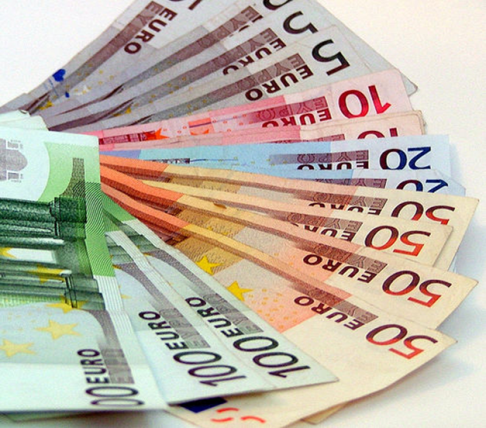
On the front side of each euro banknote depicts the gates and windows that symbolizes the spirit of openness. Also on the front are 12 stars - a symbol of harmony and dynamism of a united Europe.
On the reverse side is the Euro (on the reverse) shows the bridges, which symbolize the unity of European states.
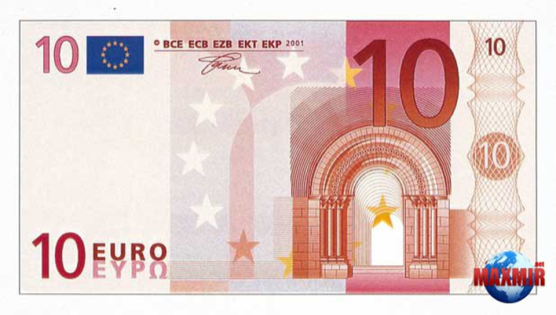

For banknotes depict structures that represent different architectural styles (Romanesque, Classical, Gothic, Baroque and Rococo, Renaissance, Art Nouveau, "metal and glass"). Also on the reverse side of the banknote Euro together with bridges and shows a map of Europe.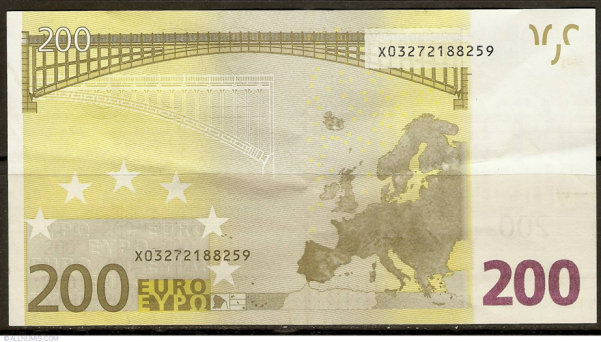
All European banknotes are printed on paper made of pure cotton, so the touch data denominations differ significantly from ordinary paper.
All Euro banknotes have a hologram, and therefore its absence is considered the first evidence that this is a forged banknote Euro.
TEXT 5: THE RUSSIAN RUBLE 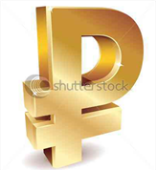
Basis of currency system of the Russian Federation - the Russian ruble introduced into circulation in 1993 and which replaced ruble of the USSR.
Last time rubles were modified in 2010 when changes were made to the image of some banknotes. Face values of Russian ruble happen:
• paper monetary units happen from 10 rubles to 5000 rubles;
• coins happen from 1 kopek to 50 kopeks and from 1 ruble to 10 rubles.
On the modern note of 100 rubles the capital of Russia - the city of Moscow is represented, namely on the face of the note Apollo with the horses, and on the back a panorama of Theatre Square with the same Bolshoi theater is represented. The banknote is executed on design of a banknote of Bank of Russia of a sample of 1995.
On the note of 500 rubles on the face the monument to Peter the Great, the sea river station of Arkhangelsk and a bark "Sedov" (the sailing ship) is represented. And on the reverse party - church of Solovetsky Monastery which isn't topped with domes, because of the fires 1923 and 1932.
Основа валютной системы Российской Федерации - российский рубль, введенный в обращение в 1993 г. и заменивший рубль СССР.
В последний раз рубли были модифицированы в 2010 году, когда были внесены изменения в изображение некоторых банкнот. Номиналы российского рубля бывают:
• бумажные денежные единицы бывают от 10 рублей до 5000 рублей;
• монеты бывают от 1 копейки до 50 копеек и от 1 рубля до 10 рублей.
На купюре в 100 рублей изображена столица России - город Москва, а именно на лицевой стороне купюры изображен Аполлон со своими лошадьми, а на оборотной стороне панорама Театральной площади с тем же Большим театром. Банкнота выполнена по дизайну банкноты Банка России образца 1995 г.
На купюре в 500 рублей на лицевой стороне изображен памятник Петру Великому, морской речной вокзал г. Архангельска и барк «Седов» (парусный корабль). А на оборотной стороне - церковь Соловецкого монастыря, которая не увенчана куполами, из-за пожаров 1923 и 1932 годов.
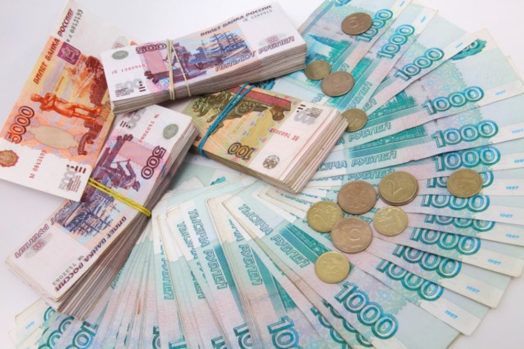

Now on the face discharged all coins denominations you can see the relief image of Saint George.

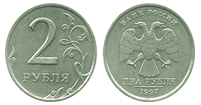
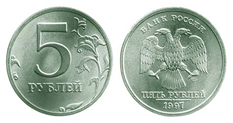
On the backs of coins it is specified the rate. The numbers and the inscriptions are displaced to the right of the centre.
On the face of these coins it is figured the double-headed eagle, over it you can see the inscription "Bank of Russia" in a circle. Underneath it is minted the inscription of 1, 2, 5 rubles. On the backs of coins the numbers with the rate of the coin are displaced to the left of the centre
TEXT 6: CHANGING MONEY OVER THE COUNTER
Selling and buying foreign currency for local currency is usually carried out in our country at bureaux de change, which are also referred to as exchange bureaux, exchange offices, or sometimes simply exchange.
In foreign countries the trade in money with customers is usually carried out at bureaux de change, at the bank counters or travel agents' offices.
The exchange rates for various currencies are determined by market forces and they change every day. The exchange rates for currencies sold and bought in bureaux de change, over the bank counters or of travel agents', are only valid regionally. For amounts in excess of a certain sum some- times special exchange rate is set.
Here is one of many dialogues that is taking place in a bureau de change in New York:
Customer:
Could you change dollars into English pounds sterling?
Cashier:
Certainly, sir. I'll just check the exchange rates. How much would you like to change?
Customer:
One thousand dollars. And what is the rate of exchange today?
Cashier:
One dollar to seventy five pence.
Customer:
And what rate can you offer for two thousand dollars?
Cashier:
One dollar to ninety pence.
Customer:
Oh, the difference is not very big. Change one thousand, please. Here is the money.
Cashier:
Thank you. May I have your passport for a moment please? We are always to write down the number of the customer's passport if we change one thousand dollars or more.
Customer:
Here it is. No problem.
Cashier:
Here is your passport. How would you like the money, sir?
Customer:
Oh, give it to me in hundred pound notes, please.
Cashier:
Good. One hundred, two hundred... seventy pounds, seventy five pounds.
Customer:
Thank you. Good morning.
Cashier:
Good morning, sir.
Vocabulary
counter
прилавок, стойка
over the counter
через стойку
at the counter
за стойкой
bureau фр.
pl. bureaux - мн.ч.
['bju'rou]
бюро (мн. число этого существительного образуется по правилам грамматики франц. яз.)
bureau de change
бюро обмена
to refer to smth as ...
называть что-либо (каким-либо словом)
to determine
[di'temin]
определять
market
рынок
market forces
силы, действующие на рынке
valid
действительный, имеющий силу
validity
действительность, срок действия, законность
excess
[ik'ses]
превышение
in excess of 20 kgs
сверх 20 кг
Luggage in excess of 20 kgs is usually charged extra.
За провоз багажа сверх 20 кг обычно взимается дополнительная плата
Grammar Revision 3: Числительные (Numerals) 1-100
Количественные числительные
Cardinal Numerals
Количественные числительные
Cardinal Numerals
1
one
11
eleven
1st
first
2
two
12
twelve
2nd
second
3
three
13
thirteen
3rd
third
4
four
14
fourteen
4th
fourth
5
five
15
fifteen
5th
fifth
6
six
20
twenty
6th
sixth
7
seven
21
twenty one
7th
seventh
8
eight
30
thirty
8th
eighth
9
nine
40
forty
9th
ninth
10
ten
50
fifty
10th
tenth
60
sixty
100
a/one hundred
Exercises
15 Read and translate into Russian:
20 kgs a hundred dollars
40 tons a hundred dollar note
18 m hundred dollar notes
£ 15 one dollar notes
80 p hundreds of dollars
70 с thousands of pounds
CanD50 3 million pounds
AustrDlOO a 25 pence coin
NZP68 25 pence coins
16 Translate into English and read:
два обменных пункта восемь стодолларовых банкнот
три стойки четыре монеты по 50 центов
100 евро банкноты по 20 фунтов
сотни долларов пять банкнот по 20 евро
несколько сотен фунтов пять монет по 2 рубля и три мо-
много сотен фунтов монеты по 5 рублей
17 Read the following sentences paying attention to the intonation:
(1) 'Could you 'change 'dollars into 'English pounds?
(2) 'May I 'have your 'passport for a `moment please?
(3) 'How 'much would you 'like to change?
(4) 'What is the 'rate of ex'change to day?
(5) 'What 'rate can you 'offer for 'two 'thousand dollars?
(6) 'How would you 'like the 'money, sir?
19 Complete the sentences with the following words:
excess, exchange rates, bureaux de change, customers,
market forces, currency, valid
(1) In foreign countries the trade in money with ... is usually carried out at …
(2) … for various currencies are determined by ... and they change every day.
(3) Selling and buying foreign … for local ... is usually carried out at …
(4) The exchange rates are ... regionally.
(5) For amounts in of a certain sum sometimes special ... are set.
20 Write with words the following sums:
£ 25.20 $ 17.80 € 1,160,
21 Translate into English:
-
Какой у вас курс фунта по отношению к доллару?
-
Мне нужно обменять 50 фунтов.
-
Вам нужен паспорт?
-
Вы может обменять доллары на евро?
-
А какой у вас курс?
22 Imagine an America customer would like to change two hundred dollars into Roubles. Act out this dialogue.
TEXT 7: COUNTERFEITING
Counterfeiting of money is one of the oldest crimes in history.
In the United States, for example it was a serious problem in the past when each bank issued its own currency.
Therefore they adopted a national currency in 1863. But it did not solve the counterfeiting problem. The national currency, or the dollar, was soon counterfeited so widely, that it became necessary for the US Government to take special measures. In 1865 the United States Secret Service was established to suppress counterfeiting. It curtailed counterfeiting to a certain extent but this crime still exists.
The US dollar is now the most counterfeited currency in the world.
Modern photographic and printing devices, colour copiers, laser scanners have made the production of counterfeit money relatively easy.
A lot of special security features are usually used in making banknotes of every country.
In making American dollars, for example, the following security features are used:
-
red and blue fibres, embedded in the paper
-
the intaglio printing of some features
Besides, not-long ago, a few more new security features were added to US dollars. These features are as follows:
-
invisible thread embedded in the paper
- microprinting and others.
These new features appeared first in banknotes of certain denominations only. Other denominations will be gradually made with the same security features.
Vocabulary
to counterfeit ['kauntefit] подделывать
counterfeiting подделка
counterfeit note поддельная банкнота
crime ['kraim] преступление
criminal ['kriminal] преступник
преступный, криминальный
criminality преступность, виновность
to adopt [a'dopt] принимать, усваивать
adoption принятие, усвоение
to solve разрешить
to solve a problem разрешить проблему
to suppress [se'pres] пресекать, подавлять
suppression подавление, запрещение (газеты и т.д.)
to curtail [ka:'teil] сокращать, урезать
curtailment сокращение, урезывание
to a certain extent в определенной степени
device устройство
colour copier цветной копир
security [sa'kjuriti] безопасность, защита
security feature метод защиты
fibre ['faibe] волокно
fibres embedded in... волокна, вкрапленные в...
intaglio printing глубокая печать
invisible [in'vizibl] невидимый
thread [ ] нить
] нить
appearance появление; внешность
gradually [ ] постепенно
] постепенно
Exercises
23 Translate the nouns and write the verbs from which they are formed:
adoption
solution
suppression
relation
security
appearance
issue
difference
inscription
signature
portrait
feature
24 Use the following words and translate the sentences:
crimes, currency, counterfeiting, established, features
(1) …of money is one of oldest … in history.
(2) They adopted a national... in 1863.
(3) In 1865 the United States Secret Service was .... to suppress ...
(4) It curtailed ... to a certain extent but this ... still exists.
(5) The US dollar is now the most counterfeited ... in the world.
(6) New security ... are added to the dollar from time to time.
25 Give the English equivalents:
метод защиты
глубокая печать
волокна, вкрапленные в бумагу
невидимая нить
микропечать
современные ксероксы
цветные принтеры
лазерный сканер
подделывать деньги
средства защиты денег
национальная валюта
26 Sum up what the text says about the security features of American banknotes.
27 Translate into English:
-
Именно эти банкноты чаще всего подделывают.
-
Доллары сейчас подделывают в самых разных странах.
-
Постоянно изобретаются новые средства защиты банкнот.
-
Именно портрет Шекспира вы можете увидеть на обороте 20- фунтовой банкноты.
ЗАКЛЮЧЕНИЕ
Представленное учебное пособие - это необходимый элемент УМК, который может быть полезен для преподавателей при обучении Раздела 3 «Введение в деловой английский» (см. Рабочую программу). В учебном пособии рассматривается содержание Темы 3.2. «Деньги. Валюта»: Из истории возникновения денег. Национальные валюты: английский фунт стерлингов, американский доллар. Национальные валюты: евро, российский рубль. Проблема подделки денег. Методы защиты банкнот. Обмен денег. Языковые клише. Понятия «инфляция», «дефляция», «девальвация» валюты. А также для студентов специальности 38.02.01 Экономика и бухгалтерский учет по отраслям.
Представленное учебное пособие рассчитано на 8 аудиторных часов (согласно Рабочей программы) и содержит тексты, лексико-грамматические задания, вопросы для самоконтроля и тестовые задания для самопроверки (Progressive Test), дополнительный материал для студентов.
Преподаватель может выбрать темы проектов при выполнении самостоятельной работы из дополнительного материала (рубрика "IT'S INTERESTING", которые подобраны практически к каждому тексту. При подведении итогов проектной работы можно подготовить красочные буклеты и защитить работу, снабдив её презентацией.
ЛИТЕРАТУРА
1. Шевелёва С.А., Стогов В.Е. Основы экономики и бизнеса: учеб. пособие для студ. сред. проф. учебных заведений. - М.: ЮНИТИ-ДАНА, 2006.
2. Ляховицкий М.В. Методика преподавания иностранных языков. М., 1981
3. Настольная книга преподавателя иностранного языка. Справочное пособие. Минск, 2000
